Empire of Trebizond
| Empire of Trebizond | ||||||||||||||
| Successor of the Byzantine Empire | ||||||||||||||
| ||||||||||||||
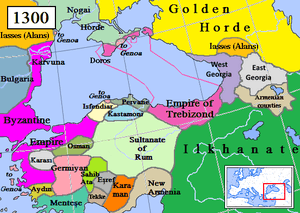 Empire of Trebizond (violet) and surrounding states in 1300 | ||||||||||||||
| Capital | Trebizond | |||||||||||||
| Languages | Greek (officially) Laz (popularly) | |||||||||||||
| Religion | Eastern Orthodoxy | |||||||||||||
| Government | Absolute monarchy | |||||||||||||
| Emperor1 | ||||||||||||||
| • | 1204–1222 | Alexios I | ||||||||||||
| • | 1459–1461 | David | ||||||||||||
| Historical era | Late Medieval | |||||||||||||
| • | Established | 1204 | ||||||||||||
| • | Disestablished | August 15, 1461 | ||||||||||||
| ||||||||||||||
| 1 the full title of the Trapezuntine emperors after 1261 was "the faithful Basileus and Autokrator of All the East, the Iberians and Perateia" | ||||||||||||||
| Warning: Value specified for "continent" does not comply | ||||||||||||||
Part of a series on the |
|---|
| History of the Byzantine Empire |
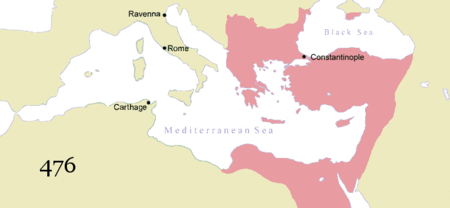 |
| Preceding |
| Early period (330–717) |
| Middle period (717–1204) |
| Late period (1204–1453) |
|
| Timeline |
| By topic |
|
|
The Empire of Trebizond or the Trapezuntine Empire was a monarchy that flourished during the 13th through 15th centuries, comprising the far northeastern corner of Anatolia and the southern Crimea. Originally formed during a revolt against the usurpation of the imperial throne by the grandsons of Emperor Andronikos I Komnenos, Trebizond (current Trabzon, Turkey) became a Byzantine Greek successor state established after the fall of the Eastern Roman Empire (Byzantine) in the Fourth Crusade, along with the Empire of Nicaea and the Despotate of Epirus.[1] The Emperors of Trebizond pressed their claim on the Imperial throne for decades after the Nicaean reconquest of Constantinople in 1261.
The Trapezuntine monarchy survived the longest of the Byzantine successor states. The Despotate of Epirus was slowly decimated, and briefly occupied by the restored Byzantine Empire c. 1340, thereafter becoming a Serbian dependency and later inherited by Italians, ultimately falling to the Ottoman Empire in 1479, having long ceased to contest the Byzantine throne. While the Empire of Nicaea had become the resurrected Byzantine Empire, it came to an end in 1453 with the conquest of Constantinople by the Ottoman Empire. The Empire of Trebizond continued until 1461 when the Ottoman Sultan Mehmed II conquered it after a month-long siege and took its ruler and his family into captivity.[2] The Crimean Principality of Theodoro, an offshoot of Trebizond, lasted another 14 years, falling to the Ottomans in 1475.
Overview
Geographically, the Empire of Trebizond consisted of the narrow strip along the southern coast of the Black Sea and the western half of the Pontic Alps, along with the Gazarian Perateia, or southern Crimea (soon losing Genoese Gazaria and Theodorite Gazaria). Its demographic legacy endured for several centuries after the Ottoman conquest in 1461 and the region retained a substantial number of Greek Orthodox inhabitants until 1923. These are usually referred to as Pontic Greeks. The eastern branch, who settled around Kars and Georgia, are often referred to as Caucasus Greeks, and the Crimean branch, resettled by Catherine the Great on the north shores of the Sea of Azov, are referred to as Mariupolitan Greeks.
The Pontic Greeks remained along the eastern Black Sea coast and its hinterland in the Pontic Alps, as well as in northeastern Anatolia, until the years immediately following the First World War, when those who had retained their Christian Orthodox faith and Greek identity fled, or were killed in, the tumultuous Pontic genocide (1917-1921). Their displacement was formalized, and the few still remaining were required to leave, in 1923 with the population exchange between Greece and Turkey. Many were resettled in Greek Macedonia. Those living in the Crimea and the Russian province of Kars Oblast, much of which lies in modern Georgia, stayed longer, with some Greek speaking villages remaining in both locations today.[3]
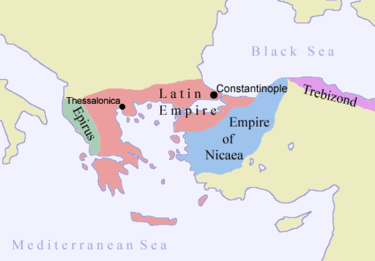
The core of the empire was the southern Black Sea coast from the mouth of the Yeşilırmak River, a region known to the Trapezuntines as Limnia, possibly as far east as Chorokhi River, a region known as Lazia; a Genoese document records the seizure of one of their ships at that port in 1437 by a military Galley at the orders of Emperor John IV.[4] Anthony Bryer has argued that six of the seven banda of the Byzantine theme of Chaldia were maintained in working order by the rulers of Trebizond until the end of the empire, helped by geography. Geography also defined the southern border of this state: the Pontic Alps served as a barrier first to Seljuk Turks and later to Turkoman marauders, whose predations were reduced to a volume that the emperors could cope with.[5] This territory corresponds to an area comprising all or parts of the modern Turkish provinces of Sinop, Samsun, Ordu, Giresun, Trabzon, Bayburt, Gümüşhane, Rize, and Artvin. In the 13th century, some experts believe the empire controlled the Gazarian Perateia, which included Cherson and Kerch on the Crimean peninsula. David Komnenos, the younger brother of the first Emperor, expanded rapidly to the west, occupying first Sinope, then coastal parts of Paphlagonia (the modern-day coastal regions of Kastamonu, Bartın, and Zonguldak) and Heraclea Pontica (the modern-day Karadeniz Ereğli), until his territory bordered the Empire of Nicaea. The expansion was, however, short-lived: the territories west of Sinope were lost to Theodore I Laskaris by 1214, and Sinope itself fell to the Seljuks that same year, although the emperors of Trebizond continued to fight for its control over the rest of the 13th century.[6]
The rulers of Trebizond called themselves Megas Komnenos ("Great Comnenus") and – like their counterparts in the other two Byzantine successor states, the Empire of Nicaea and the Despotate of Epirus – initially claimed supremacy as "Emperor and Autocrat of the Romans." However, after Michael VIII Palaiologos of Nicaea recaptured Constantinople in 1261, the Komnenian use of the style "Emperor" became a sore point. In 1282, John II Komnenos stripped off his imperial regalia before the walls of Constantinople before entering to marry Michael's daughter and accept his legal title of despot.[7] However, his successors used a version of his title, "Emperor and Autocrat of the entire East, of the Iberians and the Perateia" until the Empire's end in 1461.[8] rulers of Trebizond were also known as "Prince of Lazes".[9][10]
The Empire of Trebizond acquired a reputation in Western Europe for being "enriched by the trade from Persia and the East that passed through its capital," according to Steven Runciman, "and by the silver-mines in the hills behind, and famed for the beauty of its princesses."[11] Donald Nicol echoes Runciman's observations: "Most of the emperors were blessed with a progeny of marriageable daughters, and the beauty of the ladies of Trebizond was as legendary as the wealth of their dowries."[12] Its wealth and exotic location endowed a lingering fame on the polity. Cervantes described the eponymous hero of his Don Quixote as "imagining himself for the valour of his arm already crowned at least Emperor of Trebizond." Rabelais had his character Picrochole, the ruler of Piedmont, declare: "I want also to be Emperor of Trebizond." Other allusions and works set in Trebizond continue into the 20th century.[13]
Origins

The city of Trebizond was the capital of the theme of Chaldia, a region that had already shown separatist tendencies in the 10th and 11th centuries. Chaldia came under the control of a local leader named Theodore Gabras, who according to Anna Comnena regarded Trebizond and its hinterlands "as a prize which had fallen to his own lot" and conducted himself as an independent prince. The Byzantine Emperor Alexios I Komnenos confirmed him as governor of Chaldia, but kept his son at Constantinople as a hostage for his good conduct. Nevertheless, Gabras proved himself a worthy guardian by repelling a Georgian attack on Trebizond.[14] One of his successors, Gregory Taronites also rebelled with the aid of the Sultan of Cappadocia, but he was defeated and imprisoned, only to be made governor once more.[15] Another successor to Theodore was Constantine Gabras, whom Niketas describes as ruling Trebizond as a tyrant, and whose actions led Emperor John II Komnenos in 1139 to lead an expedition against him. Although that effort came to nothing, this was the last rebel governor known to recorded history prior to the events of 1204.[16]
The empire traces its foundation to April 1204, when Alexios Komnenos and his brother David took advantage of the preoccupation of the central Byzantine government with the encampment of the soldiers of the Fourth Crusade outside their walls (June 1203 – mid-April 1204) and seized the city of Trebizond and the surrounding province of Chaldia with troops provided by their relative, Tamar of Georgia.[17] Henceforth, the links between Trebizond and Georgia remained close, but their nature and extent have been disputed.[18]
Both men were the grandsons of the last Komnenian Byzantine emperor, Andronikos I Komnenos, by his son Manuel Komnenos and Rusudan, daughter of George III of Georgia. Andronikos I had been deposed by Isaac II Angelos, while Manuel was blinded (a traditional Byzantine punishment for treason) and died not long after. Alexios and his brother, David, ended up at the court of Queen Tamar of Georgia, who gave them military support to return to Byzantine territory. Vasiliev explains that she had been motivated to do so after the Emperor Alexios III Angelos stole the gifts Tamar had given to a group of visiting monks as they passed through Constantinople.[19] While Michel Kurskanskis has argued in support of Vasiliev's interpretation, he disagrees with Vasiliev over the intent of Tamar's intervention: Vasiliev has argued that the Queen intended to create a buffer state to protect the Georgian Kingdom, while Kurskanskis believes she supported the brothers in their attempt to reclaim the Byzantine throne in Constantinople.[20]
The Empire up to the civil wars
After marching from Georgia, and with the help of their paternal aunt Queen Tamar, Alexios and David occupied Trebizond in April 1204.[21] That same month Alexios was proclaimed emperor at the age of 22, an act considered by later writers as the moment the Empire of Trebizond was founded.
The date Alexios entered Trebizond may be narrowed down even further. Sergey Karpov has identified a lead seal of Alexios, on one side "the image of a strategos in the peaked helmet leaded by hand by St. George" with the inscriptions Ἀλέξιος ὁ Κομνηνός [Alexios Komnenos] and Ὁ Ἅ(γιος) Γεώργιος [Saint George] on either side; on the obverse is a scene of Ἡ Ἁγία Ἀνάστασις [The Holy Resurrection] with the corresponding inscription. Karpov interprets the significance of this image and the inscription as portraying the most important achievement of his life, St. George inviting the victorious prince to enter Trebizond and opening the gates of the city with his left hand. The importance of St. George was that Easter—the date of the Resurrection—in 1204 fell on 25 April, while the memorial date of St. George was 23 April. "So I dared to assume," writes Karpov, "that the seal points out the date of the capture of Trebizond."[22]
Vasiliev points out that the brothers occupied Trebizond too early to have done so in response to the Crusaders capturing Constantinople; Alexios and David began their march on Trebizond before news of the sack of Constantinople on 13 April 1204 could reach either Trebizond or Georgia. According to Vasiliev, however, their original intention was not to seize a base from which they could recover the capital of the Byzantine Empire, but rather to carve out of the Byzantine Empire a buffer state to protect Georgia from the Seljuk Turks.[23] Kuršanskis, while agreeing with Vasiliev that Tamar was motivated by revenge for Alexios Angelos's insult, proposed a more obvious motivation for the brother's return to Byzantine territory: they had decided to raise the banner of revolt, depose Alexios Angelos, and return the imperial throne to the Komnenos dynasty. However, not long after they had gained control of Trebizond and the neighboring territories, news of the Latin conquest of Constantinople reached them, and the brothers entered the competition for recovery of the imperial city against Theodore I Laskaris in western Anatolia (ruler of the "Empire of Nicaea") and Michael Komnenos Doukas in mainland Greece (ruler of the "Despotate of Epirus").[24]
For most of the 13th century Trebizond was in continual conflict with the Seljuk Sultanate of Rûm and later with the Ottoman Turks, as well as Constantinople, the Italian republics, and especially the Republic of Genoa. It was an empire more in title than in fact, surviving by playing its rivals against each other, and offering the daughters of its rulers, who were famed for their beauty, for marriage with generous dowries, especially with the Turkish rulers of inland Anatolia. The common view is that the Empire of Trebizond relied heavily upon wealth gained from its trade with Genoese and Venetian merchants to secure for itself the resources necessary to maintain independence.[25]
The second son of Alexios I, Manuel I (1238–1263), preserved internal security and acquired the reputation of a great commander. His accomplishments included capturing Sinope in 1254.[26] He was the first ruler to issue silver coins, which were known as aspers.
The destruction of Baghdad by Hulagu Khan in 1258 diverted the western terminus of the Silk Road north to the Black Sea, and due to its link with their local capital at Tabriz, Trebizond accumulated tremendous wealth under the suzerainty of the Mongols.[27] Western travelers used Trebziond as their starting point for journeys into Asia; these travelers included Marco Polo, who returned to Europe in 1295 by way of Trebizond. The troubled reign of Manuel's youngest son John II (1280–1297) included a reconciliation with the restored Byzantine Empire and the end of Trapezuntine claims to Constantinople. Trebizond enjoyed a period of wealth[28] and influence during the long reign of John's eldest son Alexios II (1297–1330). During his reign, the city of Erzurum was also under Trebizond Empire occupation for a while around the 1310s.[29]
From the civil wars to the end of the 14th century
Following the death of Alexios II, Trebizond suffered a period of repeated imperial depositions and assassinations, despite a short period of stability under his youngest son Basil (1332-1340). Two groups struggled for ascendency: the Scholaroi, who have been identified as being pro-Byzantine, and the Amytzantarantes, who were identified as representing the interests of the native archontes. The years 1347-1348 marked the apex of this lawless period. The Turks took advantage of the weakness of the empire, conquering Oinaion and besieging Trebizond, while the Genoese seized Kerasus. In addition, the Black Death spread from Caffa to ravage Trebizond and other Pontic cities. Bending under the weight of the disasters that accumulated on his states, Emperor Michael abdicated in 1349 in favor of his nephew, Alexios III, who gradually brought the partisans of both factions under control.
Under the rule of Alexios III, Trebizond was considered an important trade center and was renowned for its great wealth and artistic accomplishment. It was at this point that their famous diplomatic strategy of marrying the princesses of the Grand Komnenos to neighboring Turkish dynasts began. However, Anthony Bryers has argued against thinking this empire was a wealthy polity, stating that while the income from taxes levied on this trade was "by Byzantine standards" substantial, as much as three quarters of the income of the Emperor came from land "either directly from the imperial estates or indirectly from taxes and tithes from other lands."[30]
Trebizond in the 15th century

The last years of the fourteenth century were characterized by the increasing Turkish threat. This threat was not from the small Turkmen emirs that bordered the Empire, but from the dynasty of the Osmanli, a new Turkish power emerging from western Anatolia that would soon be known as the Ottoman Empire. Although this new opponent, after defeating the Greeks of Constantinople and the Christian powers of the Balkans, had suffered a disaster at the Battle of Ankara in 1402 by Tamerlane, the Ottomans recovered with amazing speed, eventually conquering Thessalonika in 1430 and, above all, Constantinople on 29 May 1453. Manuel III (1390–1417), the second son and successor of Alexios III, had allied himself with Tamerlane, but the mighty conqueror soon left Anatolia, and the empire he had built crumbled with his death. His son Alexios IV (1417–1429) continued the tradition of political marriages by marrying two of his daughters to rulers of two neighboring Muslim empires: Jihan Shah, khan of the Kara Koyunlu, and Ali Beg, khan of the Ak Koyunlu. His eldest daughter Maria became the third wife of the Byzantine Emperor John VIII Palaiologos.
Alexios IV's eldest son, John IV (1429–1459), could not help but see that his Empire would soon share the same fate as Constantinople. The Ottoman Sultan Murad II first attempted to take the capital by sea in 1442, but high surf made the landings difficult and the attempt was repulsed.[31] While Murad's son and successor, Mehmed II, was away laying siege to Belgrade in 1456, the Ottoman governor of Amasya attacked Trebizond, and although defeated, he took many prisoners and extracted a heavy tribute.[32]
John IV prepared for the eventual assault by forging alliances. He sent an envoy to the Council of Florence in 1439, the humanist George Amiroutzes, which resulted in the proclamation of the Union of the Catholic and Orthodox Churches, but this proclamation brought little help. He gave his daughter Theodora (also known by the name of Despina Khatun) to the son of his brother-in-law, Uzun Hasan, khan of the Ak Koyunlu, in return for his promise to defend Trebizond. He also secured promises of help from the Turkish emirs of Sinope and Karamania, and from the king and princes of Georgia.[33] Through Theodora and the daughter of Alexios IV of Trebizond (also named Theodora), the Safavid dynasty of Iran that succeeded the Ak Koyunlu, would be of direct partial Pontic Greek ethnicity from its very beginning.
After John's death in 1459, his brother David came to power. David intrigued with various European powers for help against the Ottomans, speaking of wild schemes that included the conquest of Jerusalem. Mehmed II eventually heard of these intrigues and was further provoked to action by David's demand that Mehmed remit the tribute imposed on his brother.[33]
Mehmed's response came in the summer of 1461. He collected a sizable army at Bursa, and in a surprise move marched on Sinope, whose emir quickly surrendered. Then the Sultan moved south across eastern Anatolia to neutralize Uzun Hasan. Having isolated Trebizond, Mehmed quickly swept down upon it before the inhabitants knew he was coming, and placed it under siege. The city held out for a month before David surrendered on August 15, 1461. With the fall of Trebizond, the last independent remnant of the Byzantine Empire, as well as the Roman Empire from which the Byzantine Empire sprang, was extinguished.[34]
In the relatively limited territory of the kingdom of the Grand Komnenoi (known as the “Empire of Trebizond”) there was enough room for three dioceses: Trebizond, which was the only diocese established far in the past, Cerasous and Rizaion in Lazika, both formed as upgraded bishoprics. All three dioceses survived the Ottoman conquest (1461) and generally operated until the 17th century, when the dioceses of Cerasous and Rizaion were abolished. the diocese of Rizaion and the bishopric of Of were abolished at the time due to the Islamisation of the Laz and of the region respectively. Possibly the diocese of Cerasous was deactivated for the same reasons.[35]
Megas Komnenos dynasty
The Komnenos dynasty ruled the main Byzantine Empire from Constantinople until 1185. The table below shows the members of the family that were rulers of the Trebizond Empire from 1204 to 1461.
| Name | Portrait | Started reign | Ended reign | Notes |
|---|---|---|---|---|
| Alexios I Megas Komnenos | 1204 | 1 February 1222 | ||
| Andronikos I Gidos | 1 February 1222 | 1235 | ||
| Ioannes I Axouchos | 1235 | 1238 | ||
| Manuel I Megas Komnenos,
"The Great Captain", |
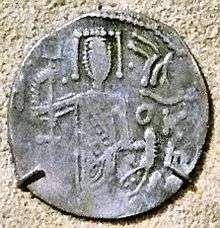 |
1238 | March 1263 | |
| Andronikos II Komnenos | March 1263 | 1266 | ||
| Georgios Komnenos | 1266 | 1280 | Deposed | |
| Ioannes II Megas Komnenos | 1280 | 1284 | First reign | |
| Theodora Megale Komnene | 1284 | 1285 | ||
| Ioannes II Megas Komnenos | 1285 | 16 August 1297 | Second reign | |
| Alexios II Megas Komnenos | 16 August 1297 | 1330 | ||
| Andronikos III Megas Komnenos | 1330 | 8 January 1332 | ||
| Manuel II Megas Komnenos | 8 January 1332 | September 1332 | Emperor for 8 months. | |
| Basileios Megas Komnenos | September 1332 | 6 April 1340 | ||
| Irene Palaiologina | 6 April 1340 | 17 July 1341 | Widow of Basileios. | |
| Anna Anachoutlou | 17 July 1341 | 4 September 1342 | Daughter of Alexios II. | |
| Ioannes III Megas Komnenos | 4 September 1342 | 3 May 1344 | ||
| Michael Megas Komnenos | 3 May 1344 | 13 December 1349 | Father of Ioannes III. | |
| Alexios III Megas Komnenos | 13 December 1349 | 20 March 1390 | ||
| Manuel III Megas Komnenos | 20 March 1390 | 5 March 1417 | ||
| Alexios IV Megas Komnenos | 5 March 1417 | 1429 | William Miller and V. Laurent have argued that Alexios was murdered in October 1429.[36] More recently, Anthony Bryer has argued on new evidence that Alexios was murdered 26 April of that year.[37] | |
| Ioannes IV Megas Komnenos | 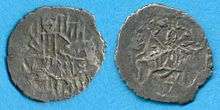 |
1429 | 1460 | Authorities offer a date for John's death from 1458 to 1460. The date offered here is taken from the latest publication on this issue.[38] |
| David Megas Komnenos | 1460 | 1461 | ||
List of Trapezuntine people
- George Amiroutzes
- George of Trebizond
- Gregory Choniades
- Johannes Bessarion
- John Lazaropoulos
- John Xiphilinos
- Michael Panaretos
See also
- Hagia Sophia, Trabzon
- Sumela Monastery
- Safavid dynasty, of (partial) Trebizond Pontic Greek descent from its very beginning.
- Dorothy Dunnett, a Scottish historical novelist, much of whose book The Spring of the Ram is set in Trebizond at the time of its fall.
- Lawrence Schoonover, an American historical novelist, much of whose book The Burnished Blade is set in Trebizond at its height.
References
- ↑ Alexander A. Vasiliev, History of the Byzantine Empire, Vol 2. 324–1453, second edition (Madison: University of Wisconsin Press, 1958), p. 506: "... on the territory of the disintegrated eastern empire, three independent Greek centers were formed; The empire of Nicaea and the empire of Trebizond in Asia Minor and the Despotat of Epirus in Northern Greece."
- ↑ William Miller, Trebizond: The last Greek Empire of the Byzantine Era: 1204-1461, 1926 (Chicago: Argonaut, 1969), pp. 100-106
- ↑ "Greeks of the Steppe". The Washington Post. 10 November 2012. Retrieved 25 October 2014.
- ↑ S. P. Karpov, "New Documents on the Relations between the Latins and the Local Populations in the Black Sea Area (1392-1462)", Dumbarton Oaks Papers: Symposium on Byzantium and the Italians, 13th-15th centuries, 49 (1995), p. 39
- ↑ Bryer, "Greeks and Türkmens: The Pontic Exception", Dumbarton Oaks Papers, 29 (1975), pp. 117ff
- ↑ As documented by Charitopoulos Evangelos, "Diocese of Cerasous. Encyclopaedia of the Hellenic World, Asia Minor"
- ↑ Nicol, Last Centuries, p. 74
- ↑ See the discussion in N. Oikonomides, "The Chancery of the Grand Komnenoi: Imperial Tradition and Political Reality", Archeion Pontou 35 (1979), pp. 299-332
- ↑ Finlay, George. The History Of Greece From Its Conquest By The Crusaders To Its Conquest By The Turks And Of The Empire Of Trebizond, 1204-1461, By George Finlay. 1st ed. Edinburgh: W. Blackwood and sons, 1851. Print.
- ↑ Vasilev, A. A. The Foundation Of The Empire Of Trebizond 1204-1222. 1st ed. Cambridge, Mass.: Medieval Academy of America, 1936. Print.
- ↑ Runciman, A History of the Crusades - the Kingdom of Arce and the Later Crusades (Cambridge: University Press, 1975), p. 126
- ↑ Nicol, The Last Centuries of Byzantium, 1261-1453, second edition (Cambridge: University Press, 1993), pp. 402f
- ↑ Miller, Trebizond, pp. 117ff
- ↑ Miller, Trebizond, p. 12
- ↑ Some authorities identify Taronites with the known son of Theodore Gabras, Gregory Gabras. See Anthony Bryer, "A Byzantine Family: The Gabrades, c. 979 – c. 1653", University of Birmingham Historical Journal, 12 (1970), p. 176
- ↑ Miller, Trebizond, p. 13
- ↑ Hewsen, Robert H. (2009). "Armenians on the Black Sea: The Province of Trebizond". In Richard G. Hovannisian. Armenian Pontus: The Trebizond-Black Sea Communities. Costa Mesa, CA: Mazda Publishers, Inc. pp. 47, 37–66. ISBN 1-56859-155-1.
- ↑ Eastmond, Antony. "Narratives of the Fall: Structure and Meaning in the Genesis Frieze at Hagia Sophia, Trebizond". Dumbarton Oaks Papers 53 (1999), 219–36.
- ↑ A. A. Vasiliev, "The Foundation of the Empire of Trebizond (1204-1222)", Speculum, 11 (1936), pp. 18f
- ↑ Michel Kuršanskis, "L'Empire de Trébizonde et la Géorgie", Revue des études byzantines, 35 (1977). pp. 243-247
- ↑ Michael Panaretos, Chronicle, ch. 1. Greek text in Original-Fragmente, Chroniken, Inschiften und anderes Materiale zur Geschichte des Kaiserthums Trapezunt, part 2; in Abhandlungen der historischen Classe der königlich bayerischen Akademie 4 (1844), abth. 1, pp. 11; German translation, p. 41
- ↑ Karpov, "New Archival Discoveries of Documents concerning the Empire of Trebizond", Gamer, 1 (2012), pp. 75f
- ↑ Vasiliev, "Foundation", p. 19
- ↑ Kuršanskis, "Trébizonde et la Géorgie", pp. 243-245
- ↑ Hewsen, "Armenians on the Black Sea", p. 48
- ↑ Maria Nystazooulou, "La dernière reconquête de Sinope par les Grecs de Trébizonde (1254-1265)", Revue des études byzantines, 22 (1964), pp. 241-9
- ↑ E.S. Georganteli, "Trapezuntine Money in the Balkans, Anatolia and the Black Sea, 13th-15th centuries", in T. Kyriakides (ed.), Trebizond and the Black Sea (Thessaloniki, 2010), p. 94
- ↑ Zehiroğlu, A.M. "Astronomy in the Trebizond Empire", (2016), pp. 2-5
- ↑ Zehiroğlu, Ahmet M. ; "Trabzon Imparatorluğu 2" 2016, Trabzon, (ISBN 978-605-4567-52-2) ; pp.133-134
- ↑ Bryer, "The Estates of the Empire of Trebizond. Evidence for their Resources, Products, Agriculture, Ownership and Location", Archeion Pontou 35 (1979), p. 371. He also includes revenue from such typical medieval sources as "the profits of justice, imperial trade and mining, confiscations and even piracy."
- ↑ Miller, Trebizond, p. 85
- ↑ Miller, Trebizond, pp. 87f
- 1 2 Nicol, Last Centuries, p. 407
- ↑ Nicol, Last Centuries, p. 408
- ↑ As documented by Charitopoulos Evangelos, "Diocese of Cerasous. Encyclopaedia of the Hellenic World, Asia Minor", (3/7/2007)
- ↑ Miller, "The Chronology of Trebizond", The English Historical Review, 38 (1923), pp. 408f; Laurent "L'Assassinat d'Alexis IV, empereur de Trebizonde", Archeion Pontou, 20 (1955), pp. 131-143.
- ↑ Bryer, "'The faithless Kabazitai and Scholarioi'", in Maistor: Classical, Byzantine and Renaissance Studies for Robert Browning, ed. Ann Moffatt (Canberra, 1984), pp. 309-327
- ↑ Ganchou, Thierre (2000), "La Date de la Mort du Basileus Jean IV Komnenos de Trebizonde", Byzantische Zeitschrift, 93: 113–124 – via De Gruyter, (subscription required (help))
Sources and research
Primary sources
- Johannes Bessarion: The praise of Trebizond
- Michael Panaretos: Chronicle
Secondary sources
- Anthony Bryer & David Winfield, The Byzantine Monuments and Topography of the Pontos (DOS. XX), vol. 1–2, Washington, 1985.
- Anthony Bryer, Peoples and Settlement in Anatolia and the Caucasus, 800–1900, Variorum collected studies series, London, 1988.
- Bryer, Anthony (1980). The Empire of Trebizond and the Pontos. London: Variorum Reprints. ISBN 978-0-86078-062-5.
- Jakob Philipp Fallmerayer, Geschichte des Kaiserthums Trapezunt (Munich, 1827–1848)
- George Finlay The History of Greece, from Its Conquest by the Crusaders to Its Conquest by the Turks, and of the Empire of Trebizond: 1204–1461. Edinburgh: Blackwood, 1851.
- Émile Janssens. Trébizonde en Colchide. Bruxelles: Presses universitaires de Bruxelles, 1969,
- Sergei Karpov. L' impero di Trebisonda, Venezia, Genova e Roma, 1204–1461. Rapporti politici, diplomatici e commerciali. Roma, 1986, 321 P.
- Sergei Karpov. Трапезундская империя и западноевропейские государства, 1204–1461. ("The Empire of Trebizond and the nations of Western Europe, 1204–1461".) Moscow, 1981, 231 pp.
- Sergei Karpov. История Трапезундской империи ("A history of the empire of Trebizond"). Saint Petersburg, 2007, 656 pp.
- William Miller, Trebizond: The Last Greek Empire, (1926; repr. Chicago: Argonaut Publishers, 1968)
- Donald Queller, Thomas Madden, The Fourth Crusade: The Conquest of Constantinople, University of Pennsylvania Press, Philadelphia, 2nd ed., 1997. ISBN 0-8122-3387-5
- Savvides, Alexios G. K. (2009). Ιστορία της Αυτοκρατορίας των Μεγάλων Κομνηνών της Τραπεζούντας (1204-1461). 2η Έκδοση με προσθήκες [History of the Empire of the Grand Komnenoi of Trebizond (1204-1461). 2nd Edition with additions] (in Greek). Thessaloniki: Kyriakidis Brothers S.A. ISBN 978-960-467-121-2.
- Rustam Shukurov. Великие Комнины и Восток (1204—1461) ("The Megas Komnenos and the Orient (1204–1461)"). Saint Petersburg, 2001, 446 pp (in Russian), ISBN 5-89329-337-1
- Levan Urushadze, The Comnenus of Trabizond and the Bagrationi dynasty of Georgia. — J. "Tsiskari", Tbilisi, No 4, 1991, pp. 144–148: in Georgian.
- Fyodor Uspensky, From the history of the Empire of Trabizond (Ocherki iz istorii Trapezuntskoy Imperii), Leningrad, 1929, 160 pp: a monograph in Russian.
- Zehiroglu, Ahmet. M. (2016). Trabzon İmparatorluğu 2 [The Empire of Trebizond (Vol.2)] (in Turkish). Trabzon: Lazika Yayin Kolektifi. ISBN 978-605-4567-52-2.
External links
-
 Media related to Empire of Trebizond at Wikimedia Commons
Media related to Empire of Trebizond at Wikimedia Commons

